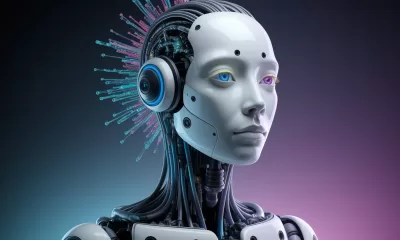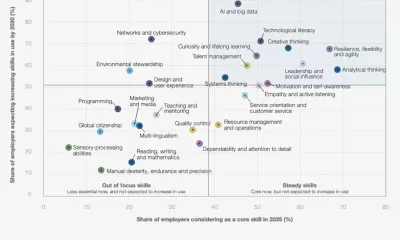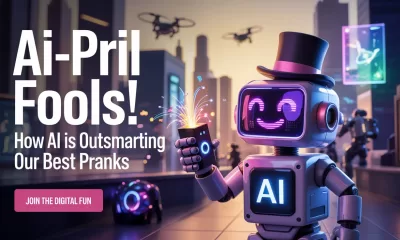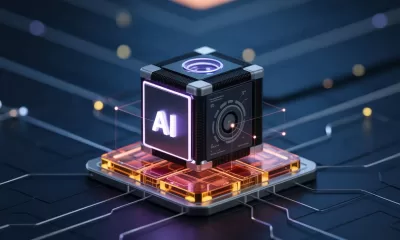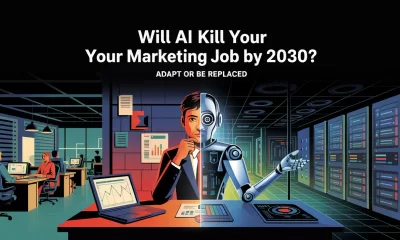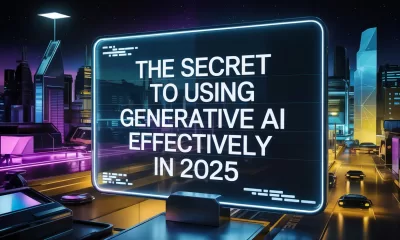Entertainment
Roblox’s AI Chat Translator Bridges Language Gaps in Global Gaming
Roblox’s AI chat translator overcomes language barriers, enabling seamless communication for millions of gamers in Asia and worldwide.
Published
1 year agoon
By
AIinAsia
TL;DR:
- Roblox introduces an AI chat translator, enabling real-time multilingual communication for 70 million daily active users.
- The feature supports 16 languages, including Chinese, Indonesian, Japanese, Korean, Thai, and Vietnamese.
- Roblox’s innovative approach to language translation showcases its commitment to efficient and effective technology.
Roblox’s AI Chat Translator: A Monumental Leap in Global Gaming
Roblox’s introduction of an AI chat translator marks a significant advancement in connecting gamers worldwide. This innovative feature allows players to form friendships across the globe, overcoming language obstacles that previously hindered social interaction.
Real-Time Multilingual Communication for 70 Million Daily Active Users
On Monday, Roblox unveiled its AI-powered chat translator, transforming the gaming experience for its 70 million daily active users. Daniel Sturman, Roblox CTO, expressed his excitement for this groundbreaking development:
“Thanks to our new real-time AI chat translations, we’ve made possible on Roblox something that isn’t even possible in the physical world — enabling people who speak different languages to communicate seamlessly with one another in our immersive 3D experience.”
The feature supports up to 16 languages, including Chinese (simplified and traditional), Indonesian, Japanese, Korean, Thai, and Vietnamese. This linguistic versatility makes it an invaluable tool for global communication.
Seamless Translation Enhances Player Interaction
Roblox’s translation service integrates within its in-experience text chat, offering automatic translations with minimal latency. This allows conversations to flow naturally, ensuring that players can engage with each other in real time. Players also have the option to view original messages, providing an authentic and immersive gaming experience.
Roblox’s Innovative Approach to Language Translation Technology
To achieve this feat, Roblox developed a transformer-based large language model (LLM) capable of translating 16 languages. This pioneering approach eliminates the need for 256 individual models, demonstrating Roblox’s commitment to efficient and effective language translation technology.
Continuous Improvement and User Engagement: The Future of Gaming
Looking ahead, Roblox is dedicated to refining its model’s accuracy. An upcoming feedback tool will empower users to report mistranslations or suggest improvements, fostering a community-driven approach to development.
Comment and Share!
Have you experienced the power of Roblox’s AI chat translator? Share your stories of cross-cultural friendships and seamless communication in the comments below!
You may also like:
- The Future of AI in European Union’s Language Interpretation
- AI Speeds Up Personalised Ads in a Cookie-Free World
- Samsung Galaxy S24: Where AI Takes Center Stage in Asia
- Southeast Asia Builds Its Own ChatGPT: SEA-LION Aims to Bridge the Language Gap
- Or visit the official website of ROBLOX by clicking here.
Author
Discover more from AIinASIA
Subscribe to get the latest posts sent to your email.
You may like
-


OpenAI’s New ChatGPT Image Policy: Is AI Moderation Becoming Too Lax?
-


Unearthly Tech? AI’s Bizarre Chip Design Leaves Experts Flummoxed
-


How Did Meta’s AI Achieve 80% Mind-Reading Accuracy?
-


How to Prepare for AI’s Impact on Your Job by 2030
-


We (Sort Of) Missed the Mark with Digital Transformation
-


DeepSeek Dilemma: AI Ambitions Collide with South Korean Privacy Safeguards
Entertainment
How AI-Assisted Music Helped Resurrect The Beatles To Grammy Nominations
“Now and Then” by The Beatles is the first AI-assisted song nominated for Grammy awards.
Published
5 months agoon
November 13, 2024By
AIinAsia
TL;DR
- “Now and Then” by The Beatles is the first AI-assisted song nominated for Grammy awards, including Record of the Year and Best Rock Performance.
- AI technology, specifically “stem separation,” was crucial in isolating John Lennon’s vocals from a low-quality cassette, enabling the completion of the song.
- The song’s release in November 2023 generated global excitement and emotional responses from fans, highlighting AI’s role in preserving artistic legacies.
The Beatles Final Encore and Grammy History
In a remarkable combination of heritage and innovation, “Now and Then” by The Beatles has achieved the distinction of being the first AI-assisted song nominated for Grammy awards, signifying an important development in both the music industry and the influence of technology on creative fields.
Recognised for Record of the Year and Best Rock Performance, this track not only displays the enduring appeal of The Beatles but also emphasises AI’s ability to revive and maintain artistic legacies for future audiences.
The Background of “Now and Then”: Recovering a Forgotten Track
1. The Late-70s Demo and Lennon’s Heritage:
Originally an unfinished recording by John Lennon, “Now and Then” was never finalised due to technical difficulties. Captured on a low-quality cassette, Lennon’s vocals could not be separated from the piano backing, and his intentions for the song remained unclear, with just fragments of lyrics and melody guiding the band years later.
2. Abandonment and Resurgence Attempts:
In the mid-1990s, Paul McCartney and the rest of The Beatles tried to finish the song but eventually abandoned the project because of sound quality concerns and possible differences in artistic vision. With advancements in machine learning, filmmaker Peter Jackson revived this aspiration in 2021, employing sophisticated audio isolation techniques to extract Lennon’s vocals and breathe new life into the song. This technology, developed for Jackson’s Get Back documentary, proved essential in revealing the band’s original artistic intentions.
The Impact of AI on “Now and Then” as AI-assisted music
1. AI-Driven Audio Isolation:
The turning point emerged from an AI-enhanced method known as “stem separation,” a state-of-the-art technique designed to isolate different audio components. In “Now and Then”, the AI effectively separated Lennon’s voice from the piano, background sounds, and low-frequency noise. This process created a clear and distinct vocal track that could harmoniously integrate with recordings from McCartney, Starr, and Harrison’s archives.
2. Audio Restoration Focused on Enhancement:
Unlike generative AI, which creates new materials, the AI employed in this process concentrated solely on refining Lennon’s initial recordings. By enhancing and isolating the pre-existing audio, it kept Lennon’s genuine voice intact, honouring both the song’s legacy and its artistic authenticity. Producer Giles Martin emphasised the goal of enhancing Lennon’s voice without producing artificial elements, guaranteeing that the vocal delivery felt genuine and historically accurate.
3. AI Restoration Versus Traditional Methods:
Previously, in audio restorations, engineers depended on manual equalisation and noise reduction methods, which often compromised sound quality. In contrast, AI provided unmatched accuracy, striking a balance between fidelity and authenticity. The technology’s capacity to identify and extract complex audio layers enabled the production team to revive the song with a clarity that traditional techniques could not match.
The Last Beatles Recording: Creation and Release
1. Contributions from All Four Members of The Beatles:
“Now and Then” brings together all four members of The Beatles, creating a musical connection across generations. Along with Lennon’s vocals, McCartney’s bass, Starr’s drumming, and Harrison’s previously recorded guitar pieces merge into a final version that captures the essence of a true Beatles song. The contributions of each member were thoughtfully blended, resulting in a track that respects both their original spirit and their individual roles.
2. Premiere and Immediate Reaction:
Released in November 2023, “Now and Then” generated important global excitement, not only for its nostalgic value but also for the way it bridged the past and present through technology. It resonated as a heartfelt farewell, eliciting strong emotional responses from fans who found comfort in the song’s enduring melody and lyrics.
Grammy Nominations: A New Chapter for AI in Music
1. Establishing Grammy Milestones with AI:
The nominations for Record of the Year and Best Rock Performance signify the first instance that an AI-enhanced work has achieved this level of acknowledgement, opening doors for future AI-assisted projects. Competing against leading contemporary artists like Beyoncé, Taylor Swift, and Billie Eilish, The Beatles have returned to prominence, once more challenging creative limits even in Grammy qualifications.
2. Grammy Policies on AI and Human Creativity:
While the Recording Academy restricts the extent to which AI can be involved, this nomination is consistent with Grammy rules that allow AI to be used as a supportive tool rather than serving as the main creator. This nomination recognises that AI, when applied with care, can enhance human craftsmanship instead of replacing it, indicating new opportunities for the music industry as AI-supported work becomes increasingly prevalent.
Public and Critical Reaction: Emotional and Technological Impact
1. The Emotional Connection to Fans:
Numerous fans shared powerful emotional responses, recounting how “Now and Then” invoked memories of Lennon, Harrison, and earlier moments associated with The Beatles’ music. The song’s thoughtful nature generated a feeling of finality, moving listeners who sensed that they were receiving a last message from the band. Social media was filled with fans sharing their experiences of how the song brought forth strong memories and ties to their personal lives.
2. Musical Praise and Mixed Reactions:
Critics applauded the song’s evocative tune and production quality, although opinions were split regarding its contemporary production style. While some listeners enjoyed the daring modern sound, others felt it either leaned too much on McCartney’s influence or lost the authenticity that characterised earlier Beatles tracks. The inclusion of AI sparked a discussion over whether this piece could genuinely be classified as a Beatles song or if it strayed too close to a McCartney creation.
3. Ethical and Artistic Concerns:
Both critics and fans questioned the song’s genuineness, with some expressing concerns that AI-assisted tracks could undermine artistic integrity. The ethical conversation focused on whether the utilisation of AI in this way respects or distorts Lennon’s original vision, particularly considering Harrison’s disreported fondness for the song. Nevertheless, this debate also positioned “Now and Then” as a technological achievement, encouraging a conversation about AI’s capability to safeguard legacies.
Breaking New Ground in AI-Assisted Music: AI and The Beatles’ Legacy
1. An Authentic Technological Triumph:
The involvement of AI in “Now and Then” presents a future in which technology can assist rather than change musical craftsmanship. By assisting precise vocal separation, AI has enabled “Now and Then” to connect with audiences as a genuine Beatles song rather than as a synthetic production. The narrative surrounding this song also emphasises how AI can be used to preserve the authenticity of historical works, providing fresh insights into cherished artists.
2. Legacy, Nostalgia, and Artistic Responsibility:
As The Beatles make Grammy history with “Now and Then”, the song emphasises the details of employing AI within legacy music. This release demonstrates how, with thoughtful application, AI can rejuvenate memories without compromising authenticity, enriching The Beatles’ narrative in a manner that feels both innovative and reflective.
Looking Forward: Future Projects and Ethical Debates
1. Possibilities for More AI-Restored Works:
This release paves the way for future endeavours, where AI could potentially restore other unfinished tracks or archival content. However, as technology advances further, the ethical concerns raised by “Now and Then” will likely shape decisions about whether and how AI should be integrated into artists’ legacies.
2. AI in Modern Music Production:
The application of AI in “Now and Then” acts as a model for how AI could support the creation of new music while preserving artistic intention. Its success is expected to motivate other artists and estates to examine how technology can connect the past to the present, and what limits might be established to maintain authenticity throughout the process.
Old Rockers Meet New Technological Innovation with The Beatles
“Now and Then” stands as an important milestone, blending innovation with nostalgia and technology with tradition. In its pursuit of Grammy recognition, the song is a testament to the capability of AI to enrich human creativity, ushering in a new chapter in music history.
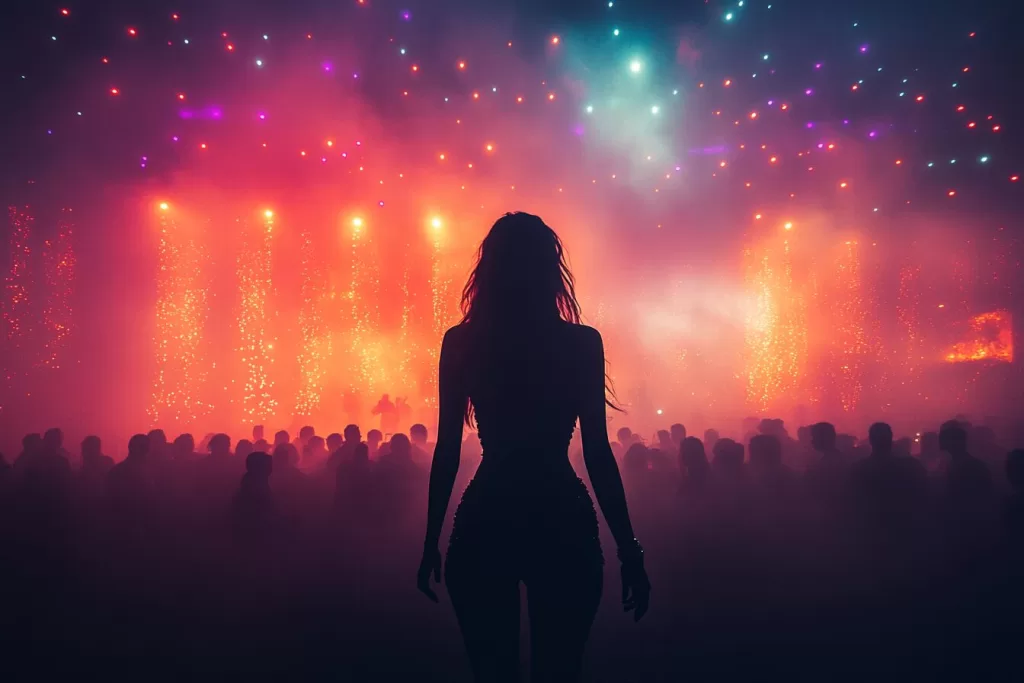
As The Beatles are honoured once again in February 2025, “Now and Then” could be recalled as both a homage to their legacy and an indicator of music’s AI-enhanced future.
You can listen to the music video on YouTube by tapping here
Join the Conversation
What are your thoughts on the future of AI in music and its potential to revive and maintain artistic legacies? We’d love to hear your opinions and experiences. Don’t forget to subscribe for updates on AI and AGI developments and share your comments below. Subscribe here.
You may also like:
- AI Music Generator: Creating Songs from Text Prompts
- AI Music Revolution: Suno Fights Back Against Record Labels
- How AI Solves the ‘Cocktail Party Problem’
Author
Discover more from AIinASIA
Subscribe to get the latest posts sent to your email.
Entertainment
An AI Thanksgiving: How Technology is Impacting Your Tradition
How AI is transforming American Thanksgiving traditions from personalised recipes to smarter travel and shopping experiences.
Published
5 months agoon
November 3, 2024By
AIinAsia
TL;DR:
- AI-driven recipes personalise Thanksgiving meals, catering to dietary needs and adding fresh flavours.
- Smart travel apps help families navigate the holiday rush with real-time updates and optimised routes.
- Virtual gatherings feel more connected with AI-enhanced video calls, VR experiences, and accessible features.
- Personalised shopping recommendations and smarter inventory management simplify Black Friday for consumers.
A New Twist on Thanksgiving Traditions
As Thanksgiving approaches in the United States, millions prepare for a holiday steeped in tradition. It’s a day marked by food, family, and gratitude—but this year, technology is adding a new layer to how these traditions unfold. With AI entering more homes and routines, Thanksgiving is evolving beyond the table to include intelligent recipes, virtual gatherings, and a smarter shopping experience. So, how is AI reshaping this traditional holiday in our digital age?
AI at the Thanksgiving Table: Beyond Basic Recipes
Thanksgiving dinner is iconic, from roast turkey to pumpkin pie. AI-driven platforms like ChatGPT and other recipe apps are now helping hosts plan and personalise these traditional dishes. Imagine needing a last-minute substitution or adapting a favourite recipe to fit new dietary preferences—AI can help adjust ingredients, cook times, and even offer cultural twists on classic dishes.
Not only does AI bring convenience, but it also enhances creativity in the kitchen. For families eager to try something new, AI can suggest recipes from diverse cultures or even create “fusion” dishes that blend Thanksgiving’s flavours with global ingredients. It’s a subtle but profound shift, transforming Thanksgiving meals into more inclusive experiences that reflect the diversity around the table.
Holiday Travel Made Smarter with AI
Thanksgiving is one of the busiest travel periods in the US, and AI-powered travel apps are taking on a vital role. From real-time route adjustments based on traffic patterns to automated updates on flight delays, AI helps families navigate the Thanksgiving rush with fewer headaches.
Platforms like Google Maps and Waze, both AI-enhanced, analyze traffic data to reroute travelers around congestion, helping families arrive in time for the holiday feast. AI-powered weather forecasting tools also provide precise updates, aiding those traveling long distances. By simplifying holiday travel logistics, AI reduces stress and maximizes the time spent together—a gift in itself during the holidays.
Virtual Gatherings with AI-enhanced Experiences
For families who can’t be together in person, AI-driven tools offer creative ways to celebrate virtually. Video conferencing platforms now feature AI-powered transcription tools, which can support family members with hearing impairments. VR technology, although still emerging, enables families to gather around a “virtual” Thanksgiving table, creating a more immersive experience than a standard video call.
AI-enhanced filters and backgrounds add a festive touch to virtual gatherings, helping to recreate the Thanksgiving atmosphere digitally. For those separated by time zones, AI can automatically suggest the best times for video calls, ensuring everyone can join in on the celebration, whether they’re sharing stories or passing along family recipes. In this way, AI makes virtual Thanksgivings feel more intimate and connected.
Smart Shopping and the AI-Driven Black Friday Experience
For many, Thanksgiving is also the gateway to Black Friday shopping, a tradition that has evolved dramatically in recent years. AI has reshaped this experience, enabling hyper-personalised shopping recommendations, real-time stock updates, and even smarter supply chains that prevent the dreaded “out of stock” message.
AI can now predict which items are likely to be popular and adjust inventory levels to meet demand. This not only makes shopping more efficient but also reduces waste by helping retailers avoid overstocking. AI-driven online shopping platforms provide personalised deals based on browsing history and purchasing patterns, allowing shoppers to find just what they need without the rush of crowds. For consumers, it’s a streamlined, stress-free way to kick off the holiday season.
AI in Entertainment: Games, Movies, and More for Thanksgiving Fun
Entertainment is central to Thanksgiving celebrations, from family movie nights to board games. AI-driven platforms like Spotify and Netflix offer curated playlists and movie recommendations tailored to everyone’s tastes, keeping the whole family entertained. For instance, AI can suggest holiday classics or even new family-friendly releases based on user preferences, setting the perfect mood for Thanksgiving evening.
Additionally, interactive gaming systems with AI components allow multiple devices to sync up, making it easy for family members to play together, whether they’re in the same room or across the country. With AI in entertainment, Thanksgiving becomes a richer, more engaging experience, tailored to bring families together and create lasting memories.
A New Kind of Thanksgiving with AI
In many ways, AI is adding depth to Thanksgiving traditions, blending the familiar with the innovative. It’s not replacing the warmth and connection of the holiday but rather enhancing it—making meals more inclusive, travel less stressful, virtual gatherings more connected, shopping smarter, and entertainment more enjoyable. As AI continues to advance, it will play an even greater role in shaping how we celebrate and connect during holidays, no matter the distance.
Comment and Share:
So, this Thanksgiving, as families sit down for a meal, shop for deals, or tune into a movie, they’ll have AI quietly working in the background, enhancing their holiday experience in ways they might not even realise. The question for next year, perhaps, is how else AI might help us cherish and connect with loved ones. How will AI transform your holiday traditions in the years to come? Subscribe for updates on AI and AGI developments and share your thoughts in the comments below!
- You may also like:
- Shopping gets a Glow Up! Google’s AI Upgrades Transform the Game
- AI Chef: How ChatGPT Created a Smash Hit Pizza
- How AI Could Uncover the Mysteries of Haunted Houses
- Or try out RecipeGPT.io, an AI-powered recipe generator where you can enter ingredients or dietary restrictions by tapping here
Author
Discover more from AIinASIA
Subscribe to get the latest posts sent to your email.
Entertainment
Ghost in the Machine: How AI Could Uncover the Mysteries of Haunted Houses
Can AI finally demystify haunted houses, or will some mysteries remain beyond reach?
Published
5 months agoon
October 30, 2024By
AIinAsia
TL;DR:
- AI is being explored as a tool in paranormal research, potentially bringing science to haunted house investigations.
- Machine learning could help detect patterns in spooky phenomena like temperature drops, strange sounds, and electromagnetic fluctuations.
- Tools like natural language processing and image recognition could assist in analysing ghostly voices (EVPs) and visual anomalies.
- AI might help explain away myths, but it could also lend credibility to genuinely unexplainable events.
Exploring the Unknown: How AI and Haunted Houses Are Becoming an Unlikely Pair
For centuries, haunted houses have captivated imaginations, igniting everything from spine-chilling horror tales to fervent ghost-hunting adventures. As Halloween brings the spectral into focus, the question lingers: can modern technology finally demystify haunted houses? Enter artificial intelligence – a tool more often associated with data and algorithms than with the supernatural.
Yet, as it turns out, AI may hold the keys to unlocking—or at least better understanding—paranormal occurrences. Imagine if data could explain creaks, shadows, and strange chills that have puzzled investigators for years. As improbable as it may sound, AI is already inching closer to solving the mysteries of the “haunted” world.
AI in Paranormal Research: A New Kind of Ghost Hunter
Until now, paranormal research has relied on a mix of psychology, folklore, and equipment that wouldn’t look out of place in a 1980s horror film. Ghost hunters use EMF readers, temperature gauges, voice recorders, and infrared cameras to collect evidence of supernatural phenomena. But what if these tools could be combined with AI to create a new level of precision?
AI excels at pattern recognition, so it’s perfectly suited to comb through hours of data, identifying correlations and potential anomalies that human eyes—or even traditional ghost-hunting gadgets—might miss. Machine learning algorithms could help sift through thousands of data points collected from haunted sites: sudden temperature drops, unexplained sounds, or electromagnetic fluctuations, each a piece of the larger puzzle. By systematically analysing these elements, AI could help us distinguish between mere environmental oddities and events that genuinely defy explanation.
The Tools of a Digital Paranormal Investigator
If AI is to become the new Sherlock Holmes of the spectral realm, it’ll need a few specialised tools. Let’s explore what the high-tech ghost-hunting kit might include:
Natural Language Processing for EVPs:
Electronic Voice Phenomena (EVPs) have long been considered potential evidence of the paranormal. Sceptics might argue that these “voices” are simply auditory pareidolia—our brain imposing meaning on random noise. But here’s where AI steps in. Using natural language processing (NLP), we could analyse EVPs more rigorously, identifying genuine speech patterns, tonal shifts, and distinguishing real words from background noise. With enough data, AI could start to build a profile of these sounds, either debunking them as misinterpretations or, intriguingly, revealing consistencies that suggest something else might be at play.
Image Recognition for Visual Anomalies:
Photographs are classic ghost-hunting artefacts, but they are frequently dismissed as lighting tricks, camera errors, or even hoaxes. However, machine learning algorithms trained on image recognition can analyse photographs, helping us separate artefacts from authentic phenomena. Suppose AI notices recurring shapes or unusual patterns in a particular location that can’t be explained by environmental factors or photo manipulation. In that case, it could give researchers a reason to look closer.
Anomaly Detection for Environmental Data:
Haunted houses are said to have their own unique “energy,” but until now, we’ve lacked a way to quantify it. Anomaly detection algorithms could monitor everything from temperature fluctuations to electromagnetic field (EMF) changes in real time, establishing baseline readings and alerting researchers when anything deviates. This way, AI isn’t just collecting data; it’s proactively looking for the moment when something out of the ordinary occurs. What’s more, it could correlate multiple data streams—such as a sudden cold spot occurring alongside a spike in EMF readings—shedding light on whether there’s any interaction between these phenomena.
Bridging the Rational and the Supernatural
AI isn’t just about debunking hauntings. In fact, it could provide believers and skeptics alike with a clearer, balanced perspective on what’s truly happening in these so-called haunted spaces. For every draft that causes a door to creak or faulty wiring that triggers strange lights, AI could offer a logical explanation, potentially demystifying many phenomena.
However, the beauty of AI is that it may also uncover genuinely unexplainable occurrences. Imagine a system that has accounted for every variable—temperature, humidity, pressure, electrical interference—and still records an anomaly that defies scientific understanding. In such instances, AI’s credibility could lend weight to claims of paranormal activity, especially in cases where all other factors have been ruled out. Far from rendering hauntings obsolete, AI could lend them a new form of credibility, giving credence to reports that have long been dismissed.
Treading Lightly on Ancient Beliefs
Using AI to delve into the paranormal isn’t merely a technical endeavour; it’s a cultural one as well. Haunted houses and ghost stories are not just frivolous folklore; they’re woven into the cultural fabric of many societies. Take Asia, where supernatural beliefs are strong, with ghosts and spirits playing roles in local traditions and societal norms. For some, these “haunted” places hold emotional significance, representing ancestors or spirits that are seen as part of everyday life rather than objects of fear.
This raises an ethical question: should AI be used to challenge or even debunk such beliefs? Technology has a long history of clashing with tradition, and there’s a risk that AI could be seen as a tool for eroding cultural heritage. An overly clinical approach could turn paranormal research into something that disregards the cultural importance of these stories. A respectful, balanced approach could instead enhance the understanding of paranormal phenomena without undermining long-standing beliefs. By respecting the human aspect of these tales, AI can be both a scientific ally and a cultural bridge.
Could AI Ever Truly Explain the Paranormal?
In the end, AI may bring a level of insight to ghost-hunting that was once the realm of imagination. By grounding supernatural research in data, AI could enable a new generation of paranormal investigators to investigate the unknown with greater precision, nuance, and respect. But could it ever truly explain the unexplainable? Probably not. Even with the most sophisticated technology, some elements of the paranormal may forever elude scientific understanding, preserving that essential bit of mystery that keeps haunted houses and ghost stories alive in our minds.
Comment and Share:
Perhaps, though, that’s for the best. In a world where data is constantly reducing unknowns, maybe we need a few things to remain beyond the grasp of AI. After all, what would Halloween be without the thrill of the unknown, the shiver down our spine, and the occasional chill in the air that no data set can quite explain? Subscribe for updates on AI and AGI developments and share your thoughts in the comments below!ou may also like:
You may also like:
- 7 GPT-4o Prompts That Will Blow Your Mind!
- 6 Stunning AI-Generated Visual Effects for Aspiring Artists
- Adrian’s Arena: AI is Shaping the Future of Marketing to Gen Z in Southeast Asia
- Now download some spooky designs this Halloween for free from website, Perfect
Author
Discover more from AIinASIA
Subscribe to get the latest posts sent to your email.

Would You Trust Tesla’s Grok AI More Than Your Friends?

Will AI Kill Your Marketing Job by 2030?

Embrace AI or Face Replacement—Grab CEO Anthony Tan’s Stark Warning
Trending
-

 Life5 days ago
Life5 days agoAI-pril Fools! How AI is Outsmarting Our Best Pranks
-

 Business3 days ago
Business3 days agoCan PwC’s new Agent OS Really Make AI Workflows 10x Faster?
-

 News3 weeks ago
News3 weeks agoAdobe Jumps into AI Video: Exploring Firefly’s New Video Generator
-

 News6 days ago
News6 days agoOpenAI’s New ChatGPT Image Policy: Is AI Moderation Becoming Too Lax?
-

 Marketing1 day ago
Marketing1 day agoWill AI Kill Your Marketing Job by 2030?
-

 Tools5 days ago
Tools5 days agoThe Secret to Using Generative AI Effectively In 2025
-

 Business2 days ago
Business2 days agoEmbrace AI or Face Replacement—Grab CEO Anthony Tan’s Stark Warning
-

 Business1 week ago
Business1 week agoForget the panic: AI Isn’t Here to Replace Us—It’s Here to Elevate Our Roles

